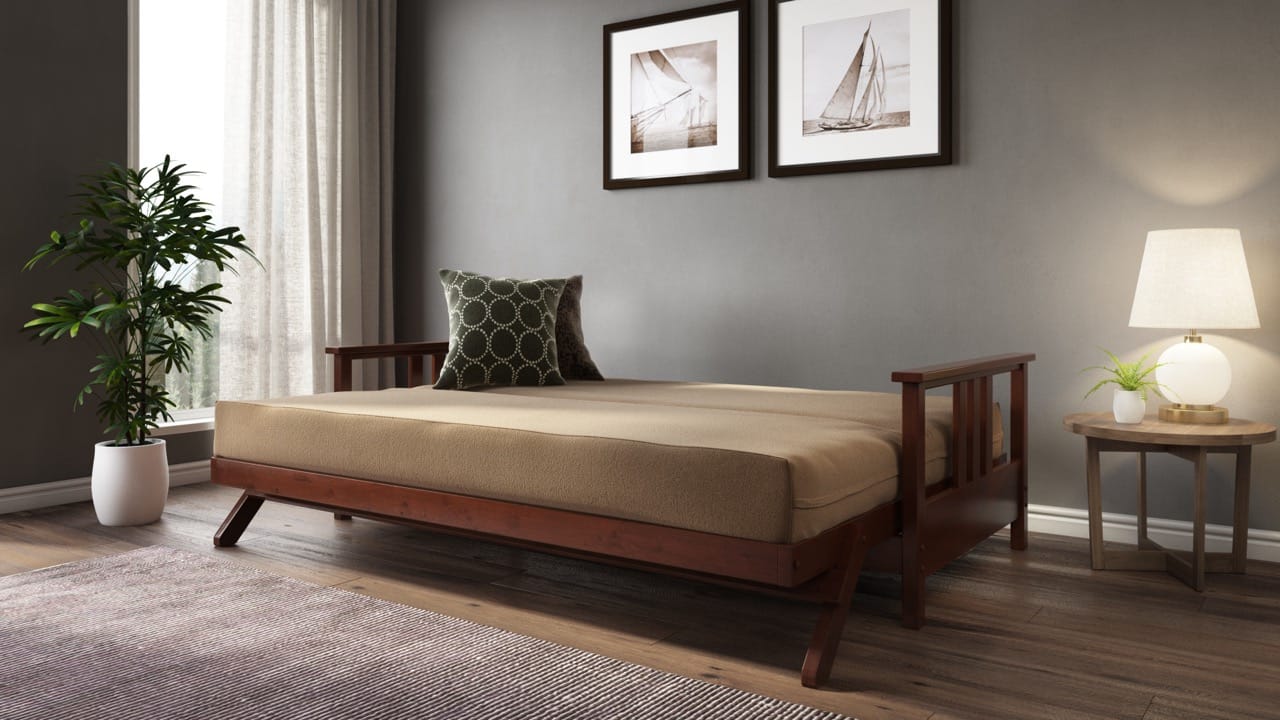The Basics
What is a futon?
A futon is a traditional Japanese bedding system that has become popular worldwide due to its versatility and space-saving benefits. It typically consists of three main components: a frame, a mattress, and a futon cover.

Traditional Japanese Futon
In Japan, a futon set includes a thin, foldable mattress called a “shikibuton” and a duvet or comforter known as a “kakebuton.” These are laid directly on the floor, usually on tatami mats, and are folded and stored away during the day. This setup is favored for its simplicity and the way it maximizes space.
Modern Futon
Outside of Japan, the term “futon” often refers to a futon sofa bed. This furniture piece combines a mattress and a convertible frame that can function as both a bed and a sofa. Modern futon frames are typically made from wood or metal and come in various styles to match different decors. The mattresses are available in a range of materials, including cotton, foam, and innerspring, to cater to different comfort preferences.
Why should I buy a futon?
Futons are a popular choice for modern homes due to their versatility, space-saving design, and cost-effectiveness. Here are several reasons why you might consider buying a futon:
- Space Efficiency. Futons are perfect for small apartments, guest rooms, or multipurpose spaces. They can function as both a bed and a sofa, allowing you to maximize the use of your space without needing separate furniture pieces.
- Versatility. Modern futons come in various styles and materials, making them suitable for different decors and purposes. Whether you need a comfortable bed for nightly use or an extra seating option for guests, a futon can adapt to your needs.
- Cost-Effectiveness. Compared to traditional beds and sofas, futons are generally more affordable. They provide a budget-friendly solution for furnishing a home without sacrificing comfort or style.
- Easy to Move and Store. Futons, especially those with lightweight frames, are easier to move than bulky furniture. Traditional Japanese futons can be easily folded and stored away when not in use, making them ideal for dynamic living spaces.
- Health Benefits. Sleeping on a futon can offer health benefits, particularly for those who prefer a firmer sleeping surface. The support provided by a futon mattress can help with spinal alignment and reduce back pain.
- Customizability. Futon mattresses and frames can be purchased separately, allowing you to customize the look and feel of your futon to suit your personal preferences. Choose from a variety of mattress materials, such as cotton, foam, or innerspring, and find a frame that complements your home decor.
How to choose the right futon?
Futons are flexible and foldable frames with mattresses that double as couches. The style you buy will depend on whether it will be used as a couch, a bed, or both, depending on your needs.
Futons fold flat when needed for sleeping and sit upright for use as a chair or sofa. It is necessary to keep both potential uses for the piece in mind when choosing a futon.
- Measure the space available for your futon in the desired room. The measurements are necessary to ensure that your futon can lie completely flat without leaning into walls or other furniture.
- Consider the materials you would like for your futon. Basic metal frames are inexpensive and great for dorm rooms but look out of place as part of a wooden living room or bedroom set. Hardwood futon frames are the most common type.
- Choose a frame model from a variety of futons in different styles, colors, and price points. Choose between a bi-fold and lounger frame. A lounger is folded twice and uses the width of the mattress as the couch. A bi-fold futon frame is folded once and uses the length of the mattress as the couch, providing more seat room.
- Check the mechanism used in a frame and the ease with which you can change its position. Inexpensive frames may look nice but may also be very difficult to operate.
- Select a futon mattress according to thickness and comfort. Inexpensive mattresses may be so thin that you are able to feel the frame beneath. Thicker mattresses are more comfortable but may be harder to fold and more expensive. Also, see what the futon mattress is made of — usually either cotton, a cotton-foam combination, a cotton-polyester blend, or a cotton-wool combination.
- Get a futon made of cotton and foam if you’re looking for a mattress that weighs less. This combination also holds its shape and doesn’t sag.
- Try a cotton-polyester blend if you’re looking for an even lighter mattress. It’s flexible and soft and holds its shape.
- Think about buying a cotton-wool combination if you want a super soft mattress. But keep in mind that cotton wool is not very flexible.
- Consider an innerspring mattress made of a spring unit that sits between layers of foam and cotton. It’s flexible and gives the feel of a traditional mattress. However, it does weigh more than the cotton and cotton combination futon mattresses.
- Purchase a washable cover, throw pillows, and other accessories to protect your investment and accent your décor.
For your convenience, we offer great deals on futon sets that come with a futon frame, a mattress, a non-slip pad, and optional covers and pillows because all of them are necessary parts of the futon.
Now that you know how to choose a futon that is right for you, let’s look closer at the main components. For your futon, you will need 3 main parts: futon frame, futon mattress, and futon cover.

Most futon frames include a futon body and a set of arms. Though sometimes the futon frame doesn’t need arms. In any case, first of all, you need to choose which kind of body you need according to your wall space and the way of use.


